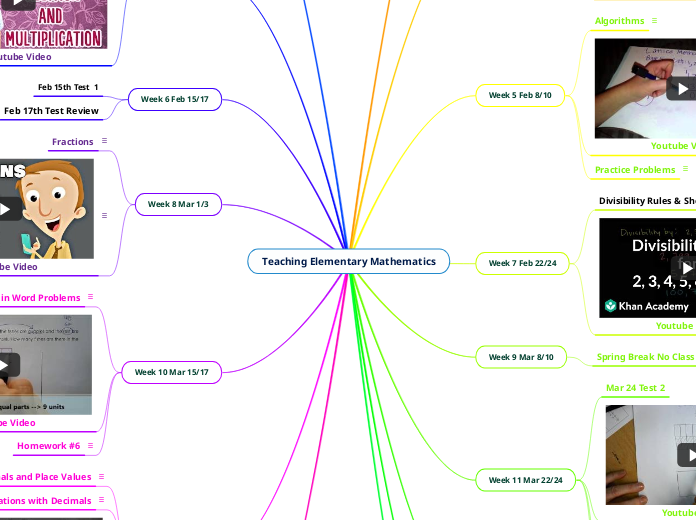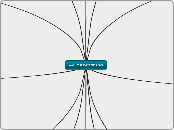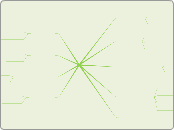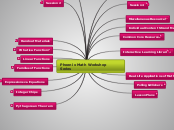Teaching Elementary Mathematics
Week 15 Apr 19/21
Operations With Positive & Negative Integers
Addition and Subtraction
+3 + -2= +1 + + + - - two cancel out leaving +1
-6 + -2= -8 - - - - - - - - add 2 negative left with -8
+3 + -4= -1 + + + add - - - - you are left -1
-2+ -1= -3 - - - ass 1 negative left with -3
+4 - -2= +6 + + + + add zero pairs - + - + left with +6
Multiplication
-2 x 5= -10
+5 x -2
-- -- -- -- --
-2 x 3= -6
3 x -2= -6
-- -- --
What will be on the final:
Prime Numbers
What is a factor and what is a multiple
2x5=10 2 and 5 are FACTORS
2,4,6,8,10,12 are MULTIPLES Of 2
Decimals: Comparing fractions, long division, repeating or terminating decimals bars in the correct place
Chip method
Percentage of different #s
Problem solving with fractions
Find least common multiple
Positive & Negative Integers
Make sure you put the bar over the repeating decimal in the right position.
Examples 1.636363 bar goes over 63
1.666666 bar goes over a 6
Research shows that a vertical number line helps students more than a horizontal number line.
Reminder multiplication is repeated addition 3x2 is 3 groups of 2
Chip method:
This method helps students understand the concept of positive and negative integers, using positive and negative chips.
If a problem calls for you to remove or add an integer that you don't have you can add zero pairs, basically a positive and a negative that cancel each other out.
In multiplication a negative times a negative is a positive. When you see the negative integer, your answer should have the opposite sign.
Also in multiplication when an equation starts with a negative integer, rearrange the equation so that the first number is positive.
Week 13 Apr 5/7
Youtube Viedo
Operations with Decimals
0.1= One tenth
0.01= One hundredth
0.101= One hundred one thousandths
0.001= One Thousandth
0.011= Eleven Thousandths
You can turn the decimal into a fraction to determine which one is smaller and multiplying by 10 if necessary to get equivalent fractions.
Be sure to line up the decimals when adding and subtracting to ensure all the digits get added to the correct place value. This needs to be emphasized to school children.
To subtract $5.00-$1.23 you tell your students to exchange $1 for 10 dimes and 1 dime for 10 pennies. When they remove $1, 2 dimes and three pennies they will see that they are left with $3.77
With multiplying, there is no need to line up the decimals when writing out the problem. After you complete the operation count the number of spaces after the decimal, that will tell you how many spaces over your decimal needs to be in your answer.
Percent means out of 100
3/100= 0.03= 3%
Fraction to percentage
2/3= 0.66= 66% 3 goes into 2 0.66 times
5/4= 5/4*20=100/80= 1.25= 125%
5/6= 0.832= 83.2% 6 goes into 5 .832 times
Decimals and Place Values
375.327
3 Hundreds
7 Tens
5 Ones
.3 tenths
2 hundredths
7 thousandths
Decimals separate the whole from the part. The decimal always sits to the right of a unit.
In money, the dollars are the unit and the decimal are the cent parts of the dollar.
Moving the decimal point to the right will show you how many dimes you need to have that specific amount.
3/10= 0.3= 30/100
3/100= 0.03
7/10= 0.70
12/100= 0.12
0.72= 72/100
Adding a zero to the decimal can help students understand the value 0.3= 0.30
Students who don't fully understand place value will make the mistake of thinking 0.73 is greater than 0.8. Adding the zero can help demonstrate that 0.73<.080
Same goes for digits like 0.125 and 0.9 0.900>0.125
Terminating decimals means it has no remainder. 0.125 is a terminating decimal.
Repeating decimals require a bar over the digits that repeat. Be sure to put the bar above the entire repeating number.
π is not a decimal because it does not stop or repeat any pattern, its considered an irrational #
Week 10 Mar 15/17
Homework #6
Homework #6
March 16, 2022
Solve both problems. As always, show your work.
1. A set of marbles can be divided in equal shares among 2, 3, 4, 5, or 6 children with no marbles left over. What is the least number of marbles this set could have? 60 marbles
2,4,6,8,10,12,14,16,18,20,22,24,26,28,30,32,34,36,38,40,42,44,46,48,50,52,54,56,58,60
2x30=60 Each child would get 30 marbles
3,6,9,12,15,18,21,24,27,30,33,36,39,42,45,48,51,54,57,60
3X20=60 Each child would get 20 marbles
4,8,12,16,20,24,28,32,36,40,44,48,52,56,60
4X15=60 Each child would get 15 marbles
5,10,15,20,25,30,35,40,45,50,55,60
5X12=60 Each child would get 12 marbles
6,12,18,24,30,36,42,48,54,60
6X10=60 Each child would get 10 marbles
2. Mary spent two thirds (2/3) of her money. She lost two thirds (2/3) of the remaining amount and then she had $8 left. How much money did she start with? $72
$48 spent, $16 lost, and $8 remaining
Fractions in Word Problems
Janice is preparing a recipe that calls for ¾ of a cup of oil per serving. If Janice needs to prepare 2 and 2/3 servings, how many cups of oil will she need?
3/4 x 8/3= 24/12= 2 cups of oil
Marc opened a pizza box. Inside there was ¾ of a pizza. Marc ate ½ of what was in the box. How much pizza did Marc eat
3/4 x 1/2= 3/8s of the whole pizza
If **** represents 2/7 of the whole, draw what the whole looks like.
**= 1/7
****= 2/7
**************= 7/7
Jim, Ken, Len and Max have a bag of miniature candy bars from trick-or-treating together. Jim took ¼ of all the bars, and Ken and Len each took 1/3 of all the bars. Max got the remaining 4 bars. How many bars were in the bag originally? How many bars did Jim, Ken and Len each get?
1/4 + 1/3 + 1/3= 1/4(3) + 2/3(4)= 3/12 + 8/12= 11/12
Max's 4 bars= 1/12
Total Bars 48
Jim 1/4= 12 bars
Ken 1/3= 16 bars
Len 1/3= 16 bars
12+16+16+4=48
Week 8 Mar 1/3
375.327
3 Hundreds
7 is Tens
5 is Ones
3 is Tenths
2 is Hundredths
7 is Thousandths
Fractions
Fractions
- A fraction is a symbol, a representation of the relationship between a part and a whole
- At 2:20 she explained that if the numerator and denominator are the same, the fraction equals 1 Example 8/8=1 6/6=1 5/5=1 3/3=1
- Quotient: 3÷5= 3/5
- Ratio: 20 students, 12 girls, 8 boys
Boys to students 8 to 20= 8/20
Girls to students 12 to 20= 12/20= 3/5
Boys to Girls ratio 8:12 this is NOT a fraction because
these are two parts, no whole
- Fractional parts are equivalent parts
- The more pieces the whole is cut into the smaller the pieces get Example of equivalent fractions: 1/2= 2/4= 4/8
- Using the least common multiple does NOT mean you will get a simplified answer
*Dividing Fractions: Leave it, change it, flip it
- Leave the first fraction the same
- Change the division symbol to a multiplication symbol
- Flip the numerator and denominator of the 2nd fraction and multiply across Example 2/3÷4/5= 2/3 X 5/4= 10/12= 5/6
- 3 groups of 2= ** ** **= 3x2
Models
Area; The surface area
Length; Number line
Set: Groups of things
Week 6 Feb 15/17
Feb 17th Test Review
Feb 15th Test 1
Week 4 Feb 1/3
Concepts and Properties of Addition, Subtraction, Multiplication and Division
Addition:
Identity Property:
When you add zero to any number that number's identity does not change. Example 7+0=7
Communitive Property: Order property
When you have 2 numbers and you add them, the order in which you add them does not matter 4+3=7 3+4=7
Associative Property: Grouping Property
Which means the way you ground them does not matter example (a+b)+c=d (a+c)+b=d
Multiplication:
Is grouping of things or numbers, example 3x2 is three groups of 2
Identity property applies to multiplication example 8x1=8
Communitive Property applies to multiplication, the order in which you multiply does not affect the outcome
Associative Property
Applies to multiplication (axb)c=(ax(bxc)
zero property:
Any number you multiply by zero is zero
Division is repeated subtraction
Week 2 Jan 18/20
211 base3
(2x9)+(1x3)+(1x1)
(2x3^3)+(1x3^1)+(1x1^0)
18+3+1=22
102base3
(1x9)+(0x3)+(1x2)
(1x3^2)+(0x3^1)+ (1x2^0)
9+0+2=11
1111base3
(1x27)+ (1x9)+(1x3)+(1x1)
(1x3^3)+(1x3^2)+(1x3^1)+(1x3^0)
27+9+3+1=40
Operations in different bases
In base 10 we operate to the tenth power and use digits 0,1,2,3,4,5,6,7,8,9
1s, 10s, 100s, 1,000s, 10,000, 100,000, 1,000,000.....
The same principle applies to all other bases.
Base 3
0,1,2
1s, 3s, 9s, 27s, 81s.....
Base 4
0,1,2,3
1s, 4s, 16s, 64s, 256s...
Base 5
0,1,2,3,4
1s, 5s, 25s, 125s, 625s...
Numeration Systems
American Standard
One to Ten Relationship
Digits Used 0-9 in Base 10
Other countries use different bases. Or example indigenous Australians use Base 5
Week 16 Apr 26/28
April 28 FInal Review
April 26 Mindmap & Review for Test
Week 14 Apr 12/14
YouTube Video
Word Problems with Percentages
1 In the United States, 13 out of every 20 cans are recycled. What percentage of cans are recycled?
13/20= 13*5/20*5=65/100=0.65= 65%
2 2% of Hamilton Middle School students have red hair. If there are 700 students how many have red hair.
700*0.02=14 also 2% of 100 is 2 for every 100 students, that means for 700 its 14 students.
There are 25 students in Ms. Johnson's class. In the class election 4 people voted for Ben, 12 voted for Sahil, 9 voted for Maria. What percentage voted for Maria?
Because there are 25 students you can just multiply the number of votes for each student by 4 and get the percentage.
Ben 4x4=16%
Sahil 4x12= 48%
Maria4x9=36%
Sophie eats a 50 gram chocolate bar which contains 30% cocoa. How many grams of cocoa are in the bar.
50*0.30=15 grams of cocoa
When a grizzly hibernates its heartbeat drops to 10 beats per minute which is 20% of the normal rate. How many times does a grizzly bears hear beat at a normal rate?
10/20*5=50/100 50 beats per minute
Of the 50 US states, 4 start with the letter W. What percentage of state start with the letter W?
4/50=8/100=0.08=8%
While waiting for a video game to download, you notice, 30% of the 32,000 kilobytes have been downloaded so far, how many kilobytes have been downloaded so far?
32,000*0.30= 9,600.00 downloaded kilobytes
Percentages
With decimals, you need to round number 5 or higher to the next whole.
To divide decimals you move the decimal of the divisor to the far right to make it a whole number, do the same to the dividend.
1 A student takes a test with 45 questions and gets 37 questions right. What is their percent on the test?
37/45= 0.822= 82.2%= 82%
2 A factory makes sandals. If they produce 820 sandals in a day and 32% of them are blue. How many are blue?
820X0.32= 262.40= 262 sandals are blue
There are three types of problems with %s
- 8 is what % of 22? = 8=n X 22= 8/22=n=0.363= 36%
- 8% of 22 is what #?= 22x0.08=1.76
- 8% of what # is 22= 0.08 X n=22= n= 22/0.08=275
The easiest way to solve these problems is to turn them into an equation, remembering that:
"is" means =
"of" means X
"what" means variable n
11% of 45 is what number?
0.11x42=4.95
9% of what number is 17?
0.09 X n= 17 n= 17/0.09= 188
17 is what percent of 25? 25/17=0.68= 68%
Week 12 Mar 29/31
Mar 31 Test Review Via Zoom
Mar 29 Test 2
Week 11 Mar 22/24
Homework #7
1. If 1/3 cup sugar is needed to make two loaves of bread, how many cups of sugar are needed for three loaves? ½ cup of sugar
1/3 x 1/2= 1/6
1/6 x 3/1= 3/6=1/2
First, I multiplied 1/3 by ½ to determine how much sugar is needed for a single loaf instead of 2 loaves. I got 1/6 I then multiplied that 1/6 by 3 to determine how much sugar is needed for three loaves and I got 3/6 which is ½ cup of sugar.
2. When the least common denominator is used in adding or subtracting fractions, is the result always a fraction in its simplest form? Explain by giving examples.
You will not always have a simplified answer even when using the least common denominator. When adding fractions, the denominators must be the same, sometimes the least common denominator will result in multiplying both denominators so you may have to simplify. It also depends on what the numerator is as well.
Examples:
5/6 – 1/3= 5/6 – 1/3(2/2)= 5/6- 2/6= 3/6= 1/2
1/3 + 1/12=1/3(4/4) + 1/12=4/12 + 5/12 =9/12 =3/4
Draw Out Fraction Multiplication Problems
Draw out problems below
- 3/4 of the class are girls, 2/3 have dark hair. What part of the class is a girl with dark hair?
3/4X2/3= 6/12=1/2 the class are girls with dark hair
Mar 24 Test 2
Week 9 Mar 8/10
Spring Break No Class
Week 7 Feb 22/24
Divisibility Rules & Shortcuts
Divisibility Rules:
- A is divisible by B if C exists
C x B=A 5x2=10 10/2=5 without a remainder
- 24 is divisible by 2 because they're both a multiple of 12 12x2=24
- 10 is divisible by 5, 10 is a multiple of 5
- 5 divides 10
- 5 is a divisor of 10
- A number is divisible by 6 if it is divisible by both 2 and 3 Example 48/6=8 48/2=24 48/3=16
- Numbers are divisible by 4 when the last two digits are divisible by 4 Example 72,328/4=18,082
- To know if a number is divisible by 8, you have to be able to divide evenly into the last three digits.
- To identify numbers divisible by 7 you have to double the last number then subtract it from the remaining digits Example 12,731 1x2=2 1,273-2=1,271 127-2=125
- To identify numbers divisible by 11 you remove the last two digits and add it to the remaining number Example 29194; 291+94= 385; 3+85=88 88 is divisible by 11
*Ending of a number
- If it ends in an even number it is divisible by 2
- When a number ends with 0 or 5 it is divisible by 5
- When a number end with 0, it is divisible by 10
*Sum of the digits
- You add all the digits, if the sum is divisible by 3, then the whole number is divisible by 3 Example 375; 3+7+5=15 375/3=125
- The same rule applies to the number nine
*Composite numbers have several factors
*Prime numbers only have 2 factors 1 and itself
*0 and 1 are not prime numbers
*When you add zero to any number, the number does not change.
0: The additive element
1: The multiplicative element
Week 5 Feb 8/10
1) American Standard
11
478
+394
872
2) Partial Sum


4 7 8
+3 9 4
1 2
1 6

+ 7
8 7 2
3) Partial Sum (B)


4 7 8
+3 9 4
1 2
1 6 0

+7 0 0
8 7 2
4) Left To Right
478
+394
700
160
+ 12
872
5) Expanded Notation
100 10
400+70+8
300+90+4
800+70+2=872
6) Lattice
4 7 8
+ 3 9 4






1 1
+ 7 6 2
8 7 2
Subtract: 645-279
1) Subtraction Standard
5 13


6 4 15
-2 7 9
3 6 6
2) European/Mexican
14 15


6 4 5
3 8


- 2 7 9
3) Reverse Indian Left to Right
14 15


6 4 5
- 2 7 9


4 7
3 6 6
4) Left to Right Place Value Emphasis
140 15


6 4 5
-2 7 9

4 0 0
3 0 0

7 0
6 0
+ 6
3 6 6
5) Expanded Notation Place Value Explicit
500 + 130 +15


645 600 + 40 + 5
-279 - 200 + 70 +9
366 = 300+ 60 + 6
6) Integer Subtraction
6 4 5
- 2 7 9
-4
-3 0
- 4 0 0
3 6 6
Algorithms
1) American Standard
2) Partial Sums
3) Partial Sums (B) Right to Left
4) Left to Right Must write place value explicitly
Week 3 Jan 25/27
Expanded Notation
Expanded Notation
375= 300+70+5
375= (3x100)+(7x10)+(5x1)
375= (3x10^2)+(7x10^1)+(5x1^1)
214= 200+10+4
(2x100)+(10x1)+(4x1)
(2x10^2)+(1x10^1)+(4x1^0)
Week 1 Jan 11/13
Practice Problems
Practice Problems
- Handshake Problem
- Basketball Problem
- Stamp Problem
Youtube Video
Polya's 4 Steps to Solving Problems
Polya's 4 Steps to Solving Problems
- Understand the problem.
- Devise a plan.
- Carry out the plan
- Take a look back and reflect
Taking a look at the work you did is the most important part of the plan. Not only does it confirm that the answer is correct put also that each step was completed properly
Strategies
Strategies:
- Students must read and understand the problem. They must reiterate the information of the problem for thorough understanding.
- Drawing out the problem or using manipulatives
- Trial and Error is a popular strategy. They must act it out then simplify the problem.
- Students must try different strategies until they figure out the problem.









